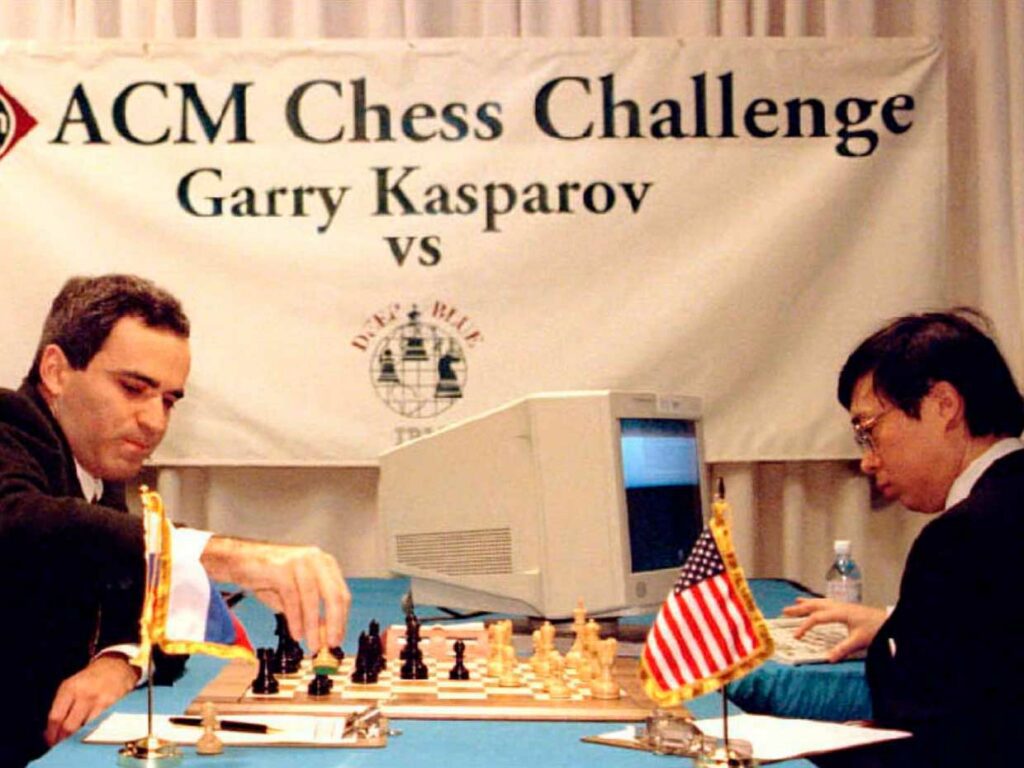The 1996 match of retired chess player Garry Kasparov and supercomputer Deep Blue contributed to establishing Garry Kasparov as one of the greatest chess players in history. Although Kasparov beat Deep Blue in 1996, Deep Blue reclaimed its honor in their 1997 chess rematch, winning the six-game battle.
No person has beaten a computer in a chess tournament since Garry Kasparov’s win against Deep Blue, IBM’s chess-playing supercomputer, in 1996.
Garry Kasparov, The Last Triumph of the Humans
As stated by an article entitled Chess engine sacrifices mastery to mimic human play, nobody has ever beaten a computer since Garry Kasparov and Deep Blue’s chess match in 1996. What exactly happened during their match, and how did that follow through?
Regarded as one of the most skillful players in chess history, Garry Kasparov was born in the Russian republic of Azerbaijan on April 13, 1963. Kasparov was bound to establish his legacy in chess, and indeed he did. By 22 years old, Kasparov became the youngest world champion ever when he won in his match with Anatoly Karpov.
Meanwhile, one of the doctoral students at Carnegie Mellon University, Feng Hsiung Hsu, began developing Deep Blue, IBM’s chess-playing computer, in 1985. Hsu initially called Deep Blue ChipTest, which he changed to Deep Thought, referencing a machine in Douglas Adams’ science-fiction novel entitled The Hitchhiker’s Guide to the Galaxy. Hsu, alongside Murray Campbell and Thomas Anatharaman, continued to work on Deep Thought even when they became employees of IBM.
In 1989, Deep Thought and Kasparov met for a 2-game match, which Kasparov easily won. With that, Deep Thought’s team continued to refine their chess-playing supercomputer, and soon, Deep Thought changed into its final name, Deep Blue, a combination of Deep Thought and Big Blue.
On February 10, 1996, at the Pennsylvania Convention Center in Philadelphia, a six-game match occurred between Deep Blue and Kasparov. Deep Blue was an intimidating opponent as he could evaluate 100 million various chess positions per second. In the first game, Kasparov lost to Deep Blue, and in the following match, Deep Blue lost. The third and fourth battles ended in a draw, but in the fifth and sixth games, Kasparov remained victorious, finalizing his win on the sixth game on February 17.
With Deep Blue’s loss, the IBM team wasted no time improving the supercomputer, succeeding in giving Deep Blue the capability to examine 200 million different chess positions per second. The succeeding year, on May 3, 1997, Deep Blue and Kasparov had a six-game rematch where Deep Blue won with a score of 3.5 to 2.5. (Source: History)
The New Artificial Intelligence Chess Engine
In 2021, a new artificial intelligence chess engine came to life with the effort of Jon Kleinberg and the rest of his team. Unlike Deep Blue, who needed to win against top chess players, Jon Kleinberg’s AI chess engine seeks to play like a human instead of beating them.
Maia, the AI model, learned to mimic human behavior with individual human chess moves. In the first week of its release, it was played more than 40,000 times.
Training the AI model on individual human chess moves, rather than on the larger problem of winning a game, taught the computer to mimic human behavior. It also created a system that is more adjustable to different skill levels – a challenge for traditional AI. Within each skill level, Maia matched human moves more than 50% of the time, with its accuracy growing as skill increases – a higher rate of accuracy than two popular chess engines, Stockfish and Leela.
Melanie Lefkowitz, Cornell Chronicle
(Source: Cornell Chronicle)
